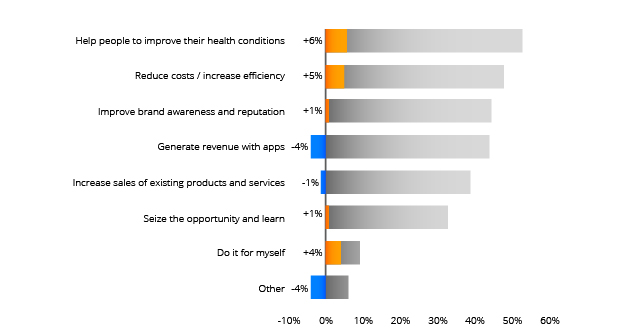 The demand for health apps continues to grow, and Snappii has already written about the role of mHealth in healthcare delivery. We also have mentioned special regulations for mHealth solutions and the role of the Health Insurance Portability and Accountability Act (HIPAA) in health app development. However, many app developers wondered when they are subject to HIPAA regulations. Fortunately, on February 11, the Department of Health and Human Services’ Office for Civil Rights (OCR) released “Health App Use Scenarios & HIPAA” (Health App Guidance), which addresses the applicability of HIPAA to mobile device apps that collect, store, manage, organize, or transmit health information.
The demand for health apps continues to grow, and Snappii has already written about the role of mHealth in healthcare delivery. We also have mentioned special regulations for mHealth solutions and the role of the Health Insurance Portability and Accountability Act (HIPAA) in health app development. However, many app developers wondered when they are subject to HIPAA regulations. Fortunately, on February 11, the Department of Health and Human Services’ Office for Civil Rights (OCR) released “Health App Use Scenarios & HIPAA” (Health App Guidance), which addresses the applicability of HIPAA to mobile device apps that collect, store, manage, organize, or transmit health information.
“Health App Use Scenarios & HIPAA” Guidance is the latest invention of OCR’s mHealth Developer Portal, a platform linked to the OCR privacy site and created for mobile health developers and others interested in the intersection of health information technology and the HIPAA privacy protection.
“These scenarios address two questions under HIPAA:
- How does HIPAA apply to health information that a patient creates, manages or organizes through the use of a health app?
- When might an app developer need to comply with the HIPAA Rules?”
Also, “Health App Use Scenarios & HIPAA” Guidance has a series of questions that developers should consider to determine whether or not they may be a business associate under HIPAA.
The Demand for mHealth Solutions
mHealth is an extremely popular solution. According to Transparency Market Research’s report, “the global mHealth services market is expected to expand at a 23.90% CAGR during the period between 2014 and 2020 owing to the rising areas of mHealth applications, increasing incidence of chronic diseases, and the increasing demand for home care services. The global mHealth services market stood at US $5.8bn in 2013 and is predicted to reach US $23.4bn by 2020”. So, to be successful in this direction, modern app developers should make sure to comply with all necessary regulations.

 Login
Login

 Nowadays education goes hand in hand with technology, so their evolution is interdependent. The mobile revolution has fundamentally changed all spheres of life, including education. In fact, students generally find learning with mobile devices more enjoyable, interactive, and effective, while teachers appreciate the affordability, accessibility, and variety of education mobile apps currently available on the market.
Nowadays education goes hand in hand with technology, so their evolution is interdependent. The mobile revolution has fundamentally changed all spheres of life, including education. In fact, students generally find learning with mobile devices more enjoyable, interactive, and effective, while teachers appreciate the affordability, accessibility, and variety of education mobile apps currently available on the market. Smartphones and mobile apps accelerate numerous processes in our life. Not surprisingly, emergency apps are on the rise since they allow users to immediately get in touch with emergency services and notify others of potential or imminent danger, thereby averting or minimizing injuries, crimes, and casualties.
Smartphones and mobile apps accelerate numerous processes in our life. Not surprisingly, emergency apps are on the rise since they allow users to immediately get in touch with emergency services and notify others of potential or imminent danger, thereby averting or minimizing injuries, crimes, and casualties.  According to the PewResearch Center, nearly two-thirds of Americans own a smartphone, and this number is expected to rise exponentially in the coming years. Nowadays thanks to mobile apps, they are not just a communication tool but a great means of work with multiple types of data. These constantly improving features make apps an extremely popular solution for field work.
According to the PewResearch Center, nearly two-thirds of Americans own a smartphone, and this number is expected to rise exponentially in the coming years. Nowadays thanks to mobile apps, they are not just a communication tool but a great means of work with multiple types of data. These constantly improving features make apps an extremely popular solution for field work.

 If you travel for business on a regular basis, you know that the organization of business trips might require a lot of time and efforts, but it doesn’t have to be that way. These days, you can obtain virtually any information to successfully and effortlessly arrange a trip, keep records, and submit reports at the click of a button on your mobile device. Special mobile apps designed for business travelers make trips more seamless, productive and less stressful.
If you travel for business on a regular basis, you know that the organization of business trips might require a lot of time and efforts, but it doesn’t have to be that way. These days, you can obtain virtually any information to successfully and effortlessly arrange a trip, keep records, and submit reports at the click of a button on your mobile device. Special mobile apps designed for business travelers make trips more seamless, productive and less stressful. According to the recent data by the University of Alabama at Birmingham, the market of mobile apps is going to keep getting bigger, and, by 2017, there will be over 268 billion downloads. That said, due to the intense competition in the modern mobile app market, it is not enough just to know how many people download your app. Instead, you also need to learn how, when, where and by what kind of audience your app is used. That is why mobile app analytics is key to remaining competitive and keep demand for your app.
According to the recent data by the University of Alabama at Birmingham, the market of mobile apps is going to keep getting bigger, and, by 2017, there will be over 268 billion downloads. That said, due to the intense competition in the modern mobile app market, it is not enough just to know how many people download your app. Instead, you also need to learn how, when, where and by what kind of audience your app is used. That is why mobile app analytics is key to remaining competitive and keep demand for your app. On January 21, Apple announced the opening of iOS App Development Center in Italy. This is the first of its kind facility in the region, and its main purpose is to provide novice developers with training and mentorship to gain necessary iOS software development skills. According to the official press release, “the center will support teachers and provide a specialized curriculum preparing thousands of future developers to be part of Apple’s thriving developer community. In addition, Apple will work with partners around Italy who deliver developer training to complement this curriculum and create additional opportunities for students”.
On January 21, Apple announced the opening of iOS App Development Center in Italy. This is the first of its kind facility in the region, and its main purpose is to provide novice developers with training and mentorship to gain necessary iOS software development skills. According to the official press release, “the center will support teachers and provide a specialized curriculum preparing thousands of future developers to be part of Apple’s thriving developer community. In addition, Apple will work with partners around Italy who deliver developer training to complement this curriculum and create additional opportunities for students”. According to the State of Retailing Online 2016 study from Forrester Research, Shop.org and Bizrate Insights, “The growing use of smartphones by consumers, a shift in investments by technology companies and continued optimization strategies from retailers have landed smartphones on top as a driver of mobile sales and traffic for retail companies”. In other words, it would be safe to say that mobile phones are here to stay and continue driving sales and customer service. Now let us take a peek at what is projected to play the most significant role in mobile commerce in 2016.
According to the State of Retailing Online 2016 study from Forrester Research, Shop.org and Bizrate Insights, “The growing use of smartphones by consumers, a shift in investments by technology companies and continued optimization strategies from retailers have landed smartphones on top as a driver of mobile sales and traffic for retail companies”. In other words, it would be safe to say that mobile phones are here to stay and continue driving sales and customer service. Now let us take a peek at what is projected to play the most significant role in mobile commerce in 2016. When publishing their apps into general app stores, their creators often wonder about the most suitable cost of their products. This task is not an easy one as it includes the analysis of app’s future maintenance, initial expenses, in-app purchases, in-app advertising, customers’ experience, and much more. It’s great if you have solid marketing skills, but what if not? Below we’ll try to shed some light on how to price your apps right.
When publishing their apps into general app stores, their creators often wonder about the most suitable cost of their products. This task is not an easy one as it includes the analysis of app’s future maintenance, initial expenses, in-app purchases, in-app advertising, customers’ experience, and much more. It’s great if you have solid marketing skills, but what if not? Below we’ll try to shed some light on how to price your apps right. Research2guidance in collaboration with the mHealth Summit in Riga have conducted the largest mHealth research so far. More than 5,000 experts shared their views to determine the status of modern mHealth and make some predictions for the next years. Here are a few findings of this research study.
Research2guidance in collaboration with the mHealth Summit in Riga have conducted the largest mHealth research so far. More than 5,000 experts shared their views to determine the status of modern mHealth and make some predictions for the next years. Here are a few findings of this research study.

 In the era of mobile technology, all businesses come to a point when they need to decide how they are going to develop mobile business apps to stay competitive. Do they build them in-house or outsource? Of course, the do-it-yourself solution ensures full compliance with one’s needs and brand. However, it also
In the era of mobile technology, all businesses come to a point when they need to decide how they are going to develop mobile business apps to stay competitive. Do they build them in-house or outsource? Of course, the do-it-yourself solution ensures full compliance with one’s needs and brand. However, it also 